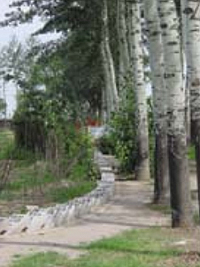Difference between revisions of "Beijing David's Deer Park Museum"
imported>Ciic m (Created page with ''''Beijing David's Deer Park Museum''', in Nanhaizi, Daxing County, Beijing, is a research organization for the protection of the David's deer. It is also an outdoor ...') |
imported>Ciic |
||
| Line 1: | Line 1: | ||
'''Beijing David's Deer Park Museum''', in [[Nanhaizi]], [[Daxing County]], [[Beijing]], is a research organization for the protection of the David's deer. It is also an outdoor ecological museum. In December 1999, the [[Chinese Association for Science and Technology]] designated the museum a national popular science educational base. | '''Beijing David's Deer Park Museum''', in [[Nanhaizi]], [[Daxing County]], [[Beijing]], is a research organization for the protection of the David's deer. It is also an outdoor ecological museum. In December 1999, the [[Chinese Association for Science and Technology]] designated the museum a national popular science educational base. | ||
| + | |||
| + | [[File:Beijing David's Deer Park Museum.jpg|thumb|300px|Beijing David's Deer Park Museum]] | ||
During the [[Yuan]] (1271-1368), [[Ming]] (1368-1644), and [[Qing]] (1644-1911) dynasties, the park served as the imperial hunting ground. The last herd of the David's deer lived here in the late Qing Dynasty, and it was not until 1865 that these precious animals were discovered by French missionary Pere Armand David, and transported to Europe. In 1900, the imperial hunting grounds were destroyed by war, and the David's deer became extinct in China. | During the [[Yuan]] (1271-1368), [[Ming]] (1368-1644), and [[Qing]] (1644-1911) dynasties, the park served as the imperial hunting ground. The last herd of the David's deer lived here in the late Qing Dynasty, and it was not until 1865 that these precious animals were discovered by French missionary Pere Armand David, and transported to Europe. In 1900, the imperial hunting grounds were destroyed by war, and the David's deer became extinct in China. | ||
Revision as of 06:51, 15 September 2009
Beijing David's Deer Park Museum, in Nanhaizi, Daxing County, Beijing, is a research organization for the protection of the David's deer. It is also an outdoor ecological museum. In December 1999, the Chinese Association for Science and Technology designated the museum a national popular science educational base.
During the Yuan (1271-1368), Ming (1368-1644), and Qing (1644-1911) dynasties, the park served as the imperial hunting ground. The last herd of the David's deer lived here in the late Qing Dynasty, and it was not until 1865 that these precious animals were discovered by French missionary Pere Armand David, and transported to Europe. In 1900, the imperial hunting grounds were destroyed by war, and the David's deer became extinct in China.
In the early 20th century, the 11th Duke of Bedford, owner of Woburn Abbey Manor in the UK, rescued the world's last 18 David's deer, thus saving this rare species from complete extinction. Through the joint efforts of the State Environmental Protection Bureau, Beijing Municipal government, and the Marquess of Tavistock from Woburn Abbey, in 1985, the David's deer were returned to Nanhaizi. During the past 17 years, the numbers of David's deer have grown from 38 to nearly 500. They have since been returned to the wild. The museum has launched various ecological tour and natural protection activities, and has built a deer viewing terrace, environmental protection publicity stands, a green maze, a cemetery for the world's extinct animals, and erected a Nanhaizi poetry stele inscribed by Emperor Qianlong. It is now the nature reserve, ecological museum, deer research center, and outdoor environmental education base nearest to Beijing city.
The History of the David's Deer Exhibition, a must-see, comprises a natural and cultural history of the David's deer, as well as the history of the park, and accompanying artifacts.
Inside the World Extinct Animals Cemetery, stones representing the animals that have become extinct since the industrial revolution are arranged domino fashion, in the hope of raising environmental awareness.
Further Information:
Address: Take buses nos. 377, 352, 946, 729, 324, 927, 859, or 926, get off at Jiugong, and walk 2.7 kilometers southward.
Open: 8:00 -- 18:00
Admission: 20 yuan
Tel: 8610-87962107; 8610-87967804; 8610-87962105
Fax:8610-8796 7805
Website: http://www.milupark.org.cn/
